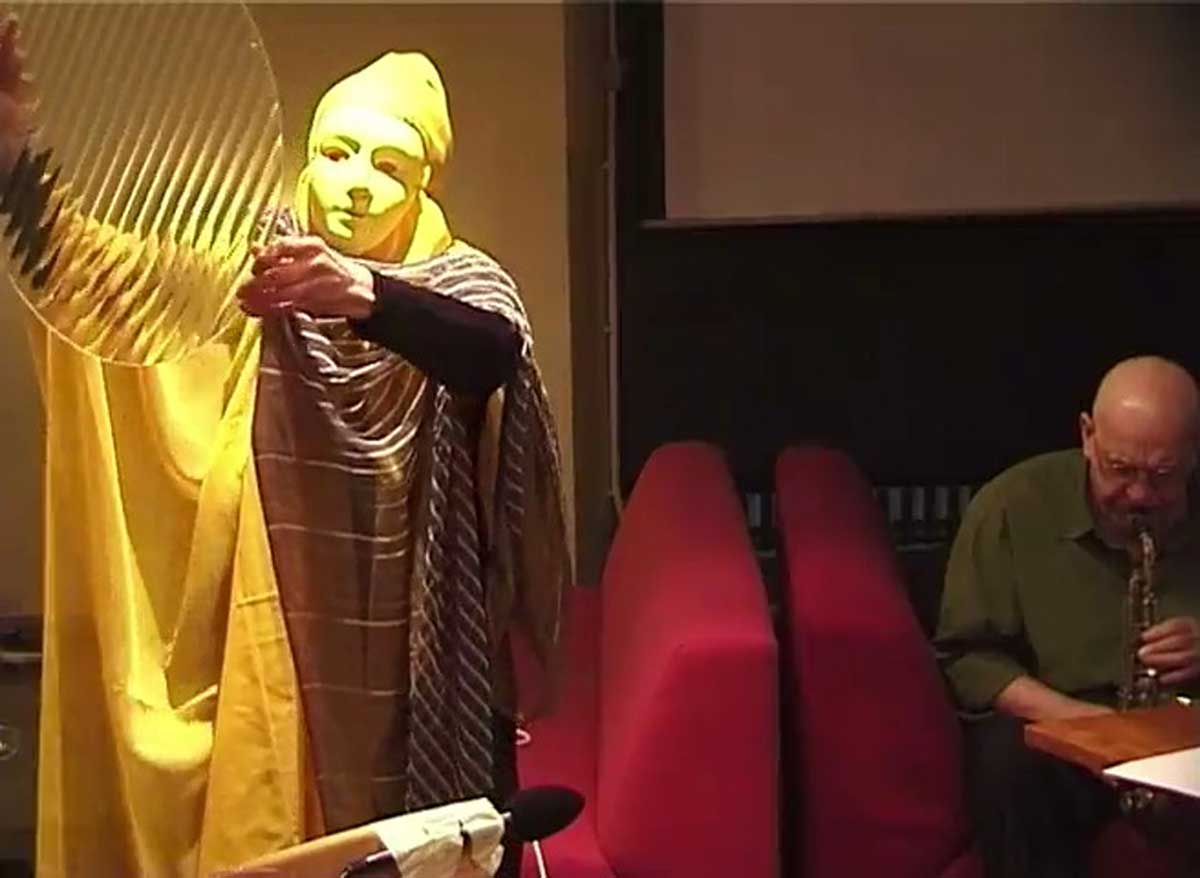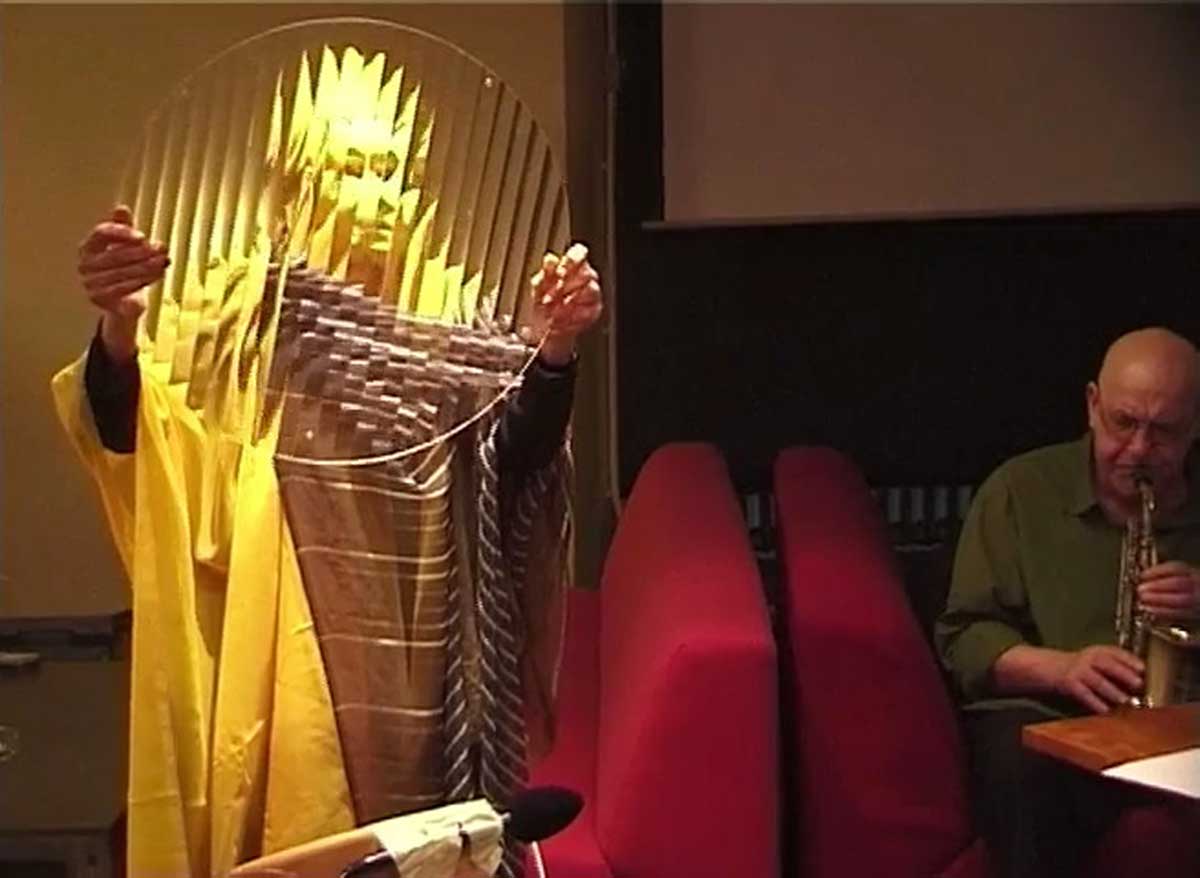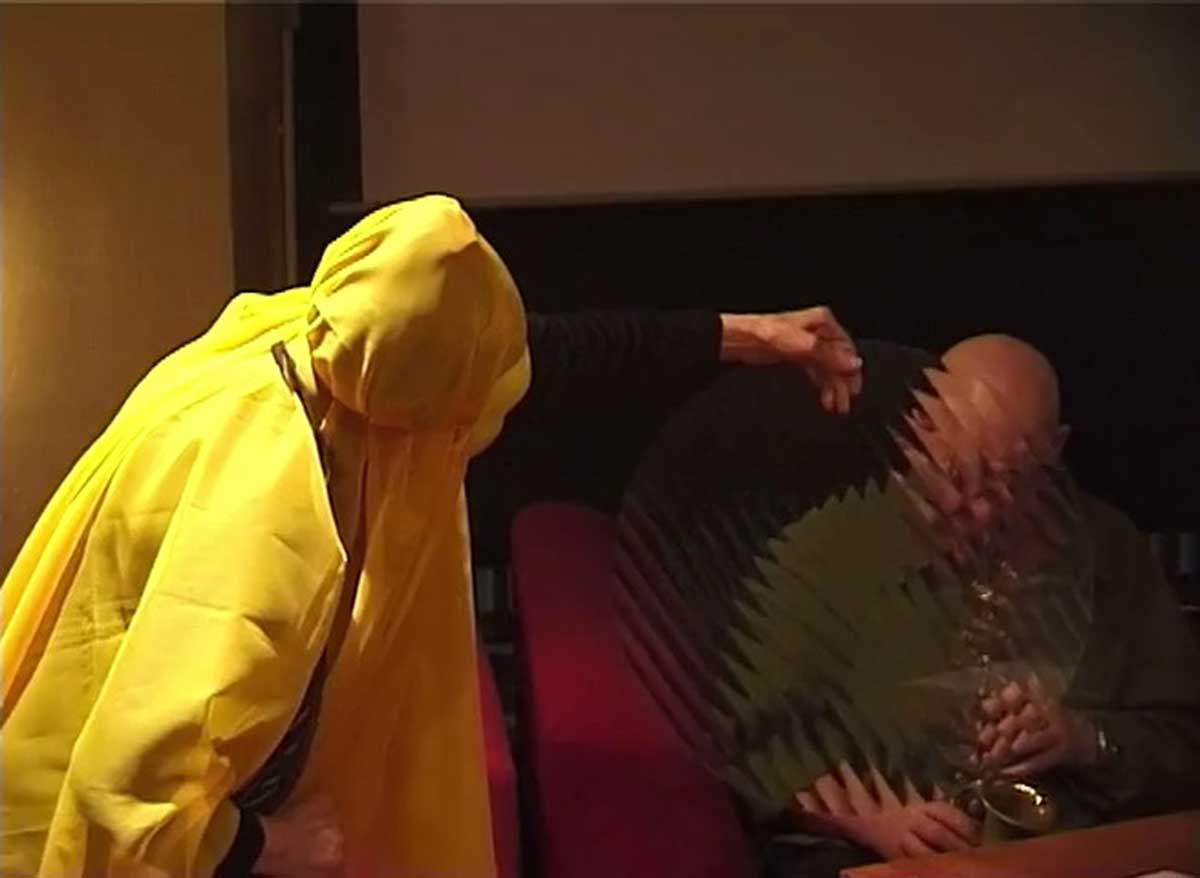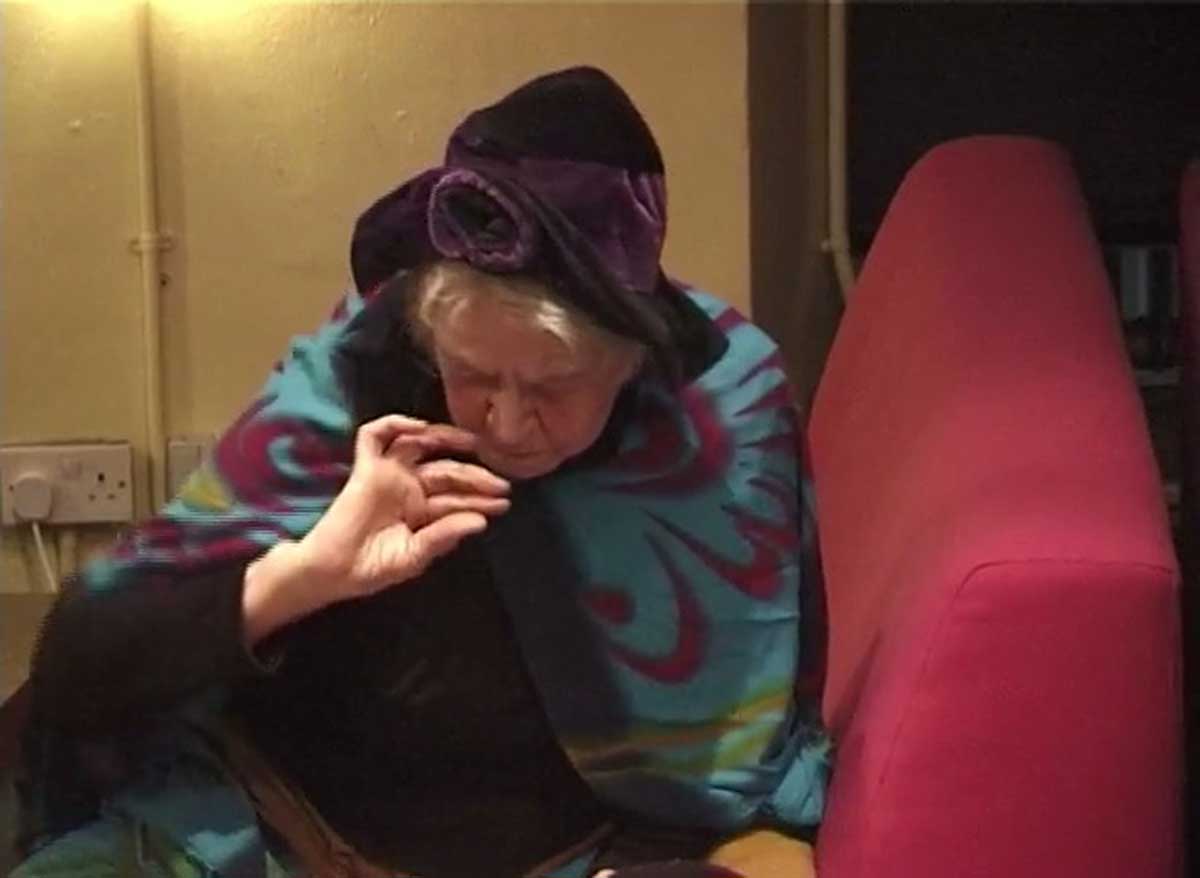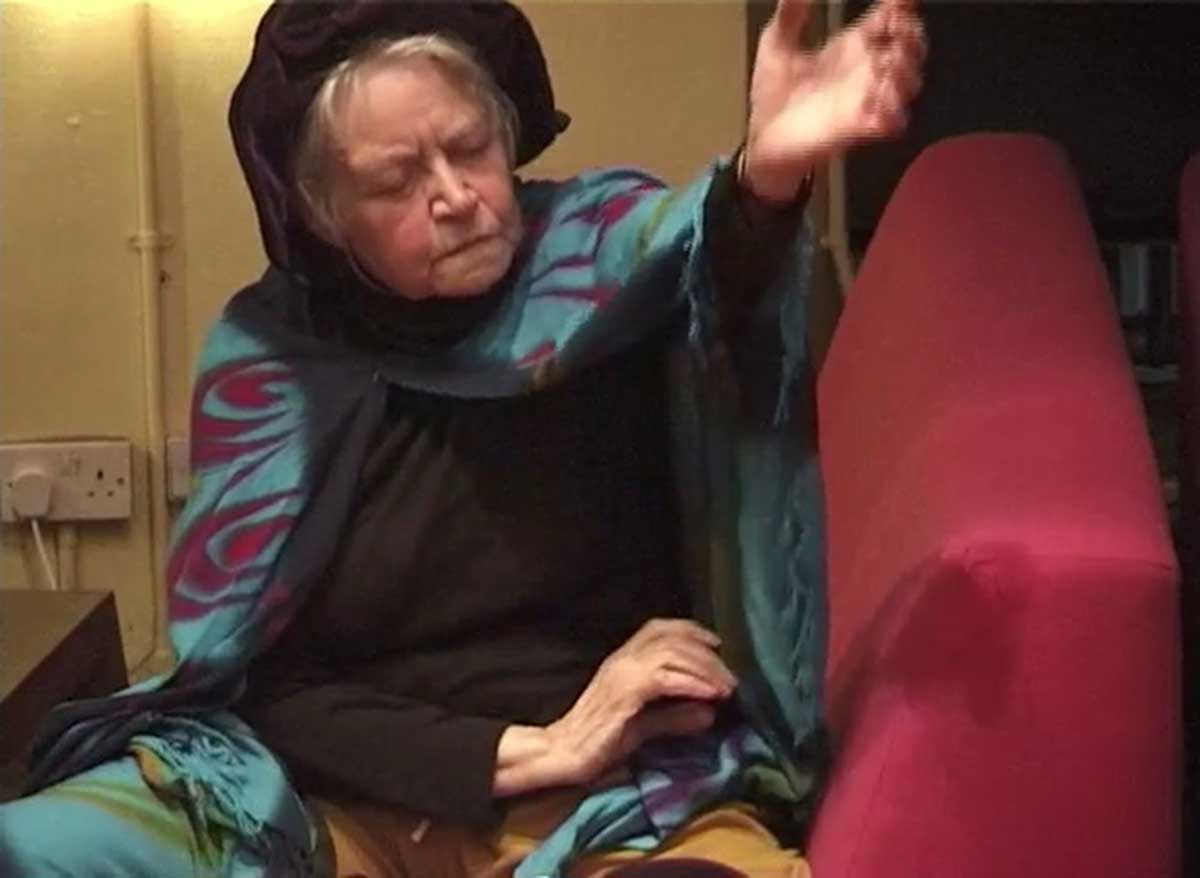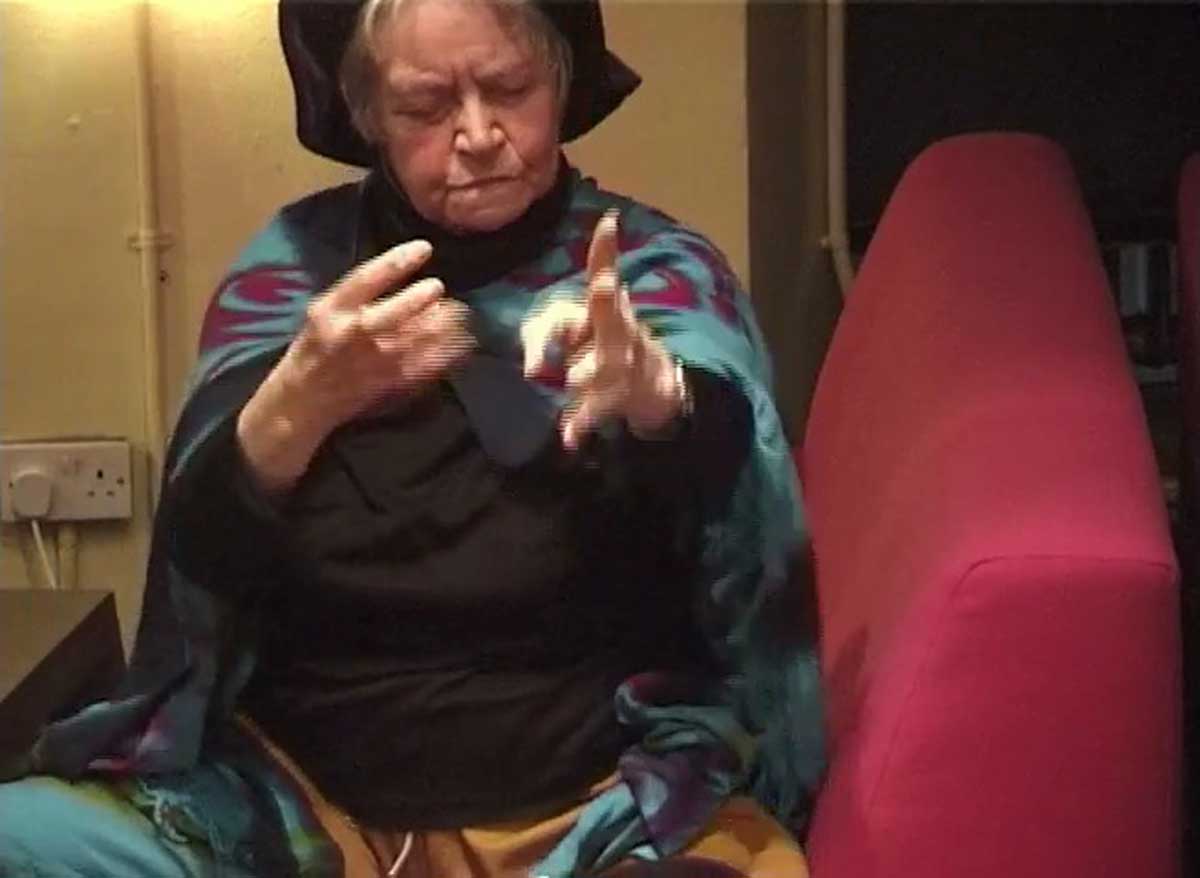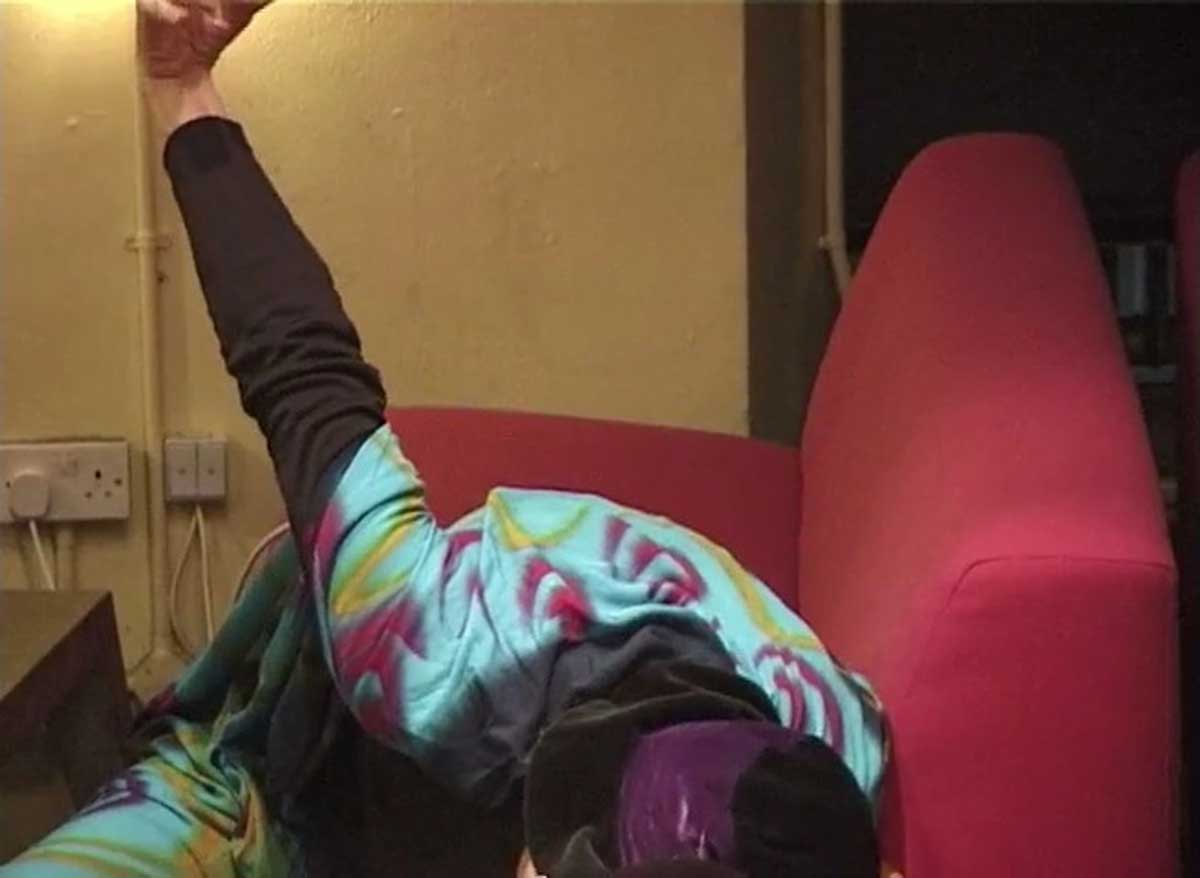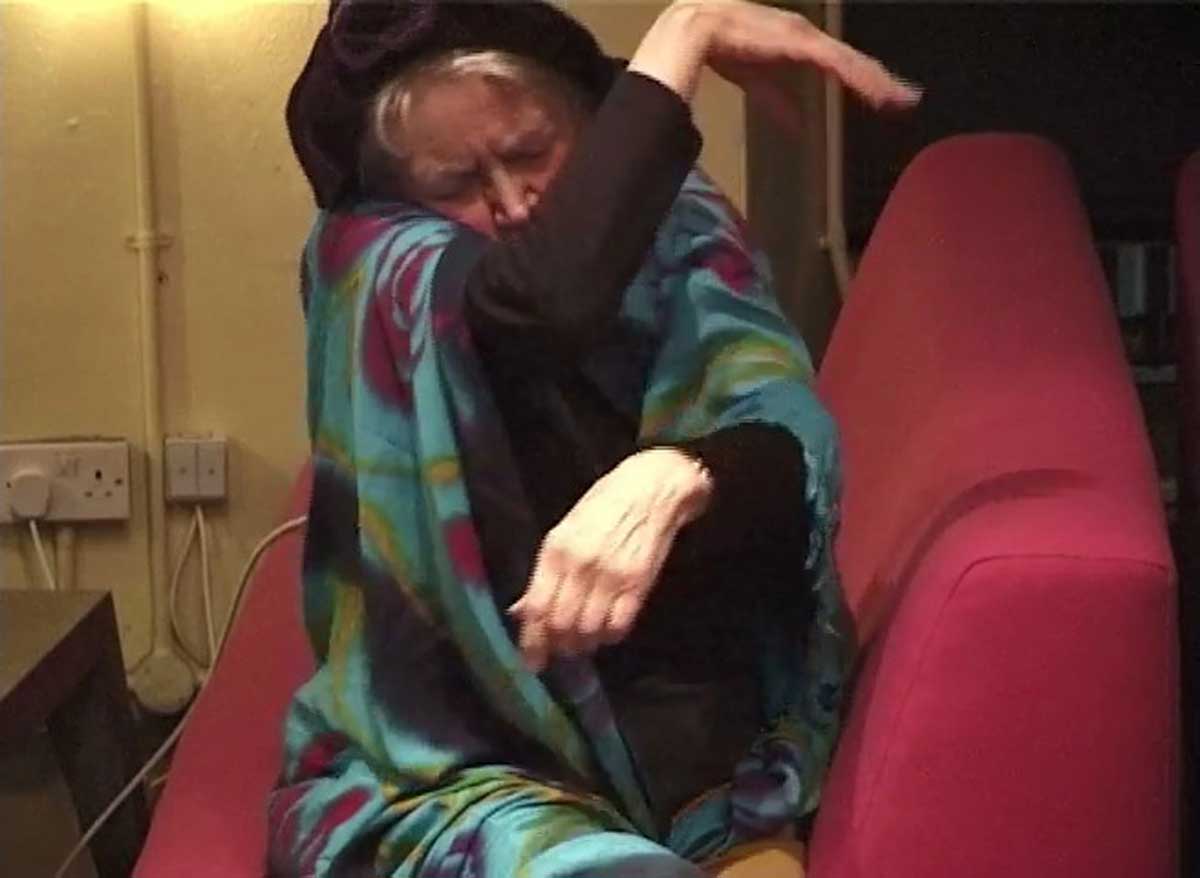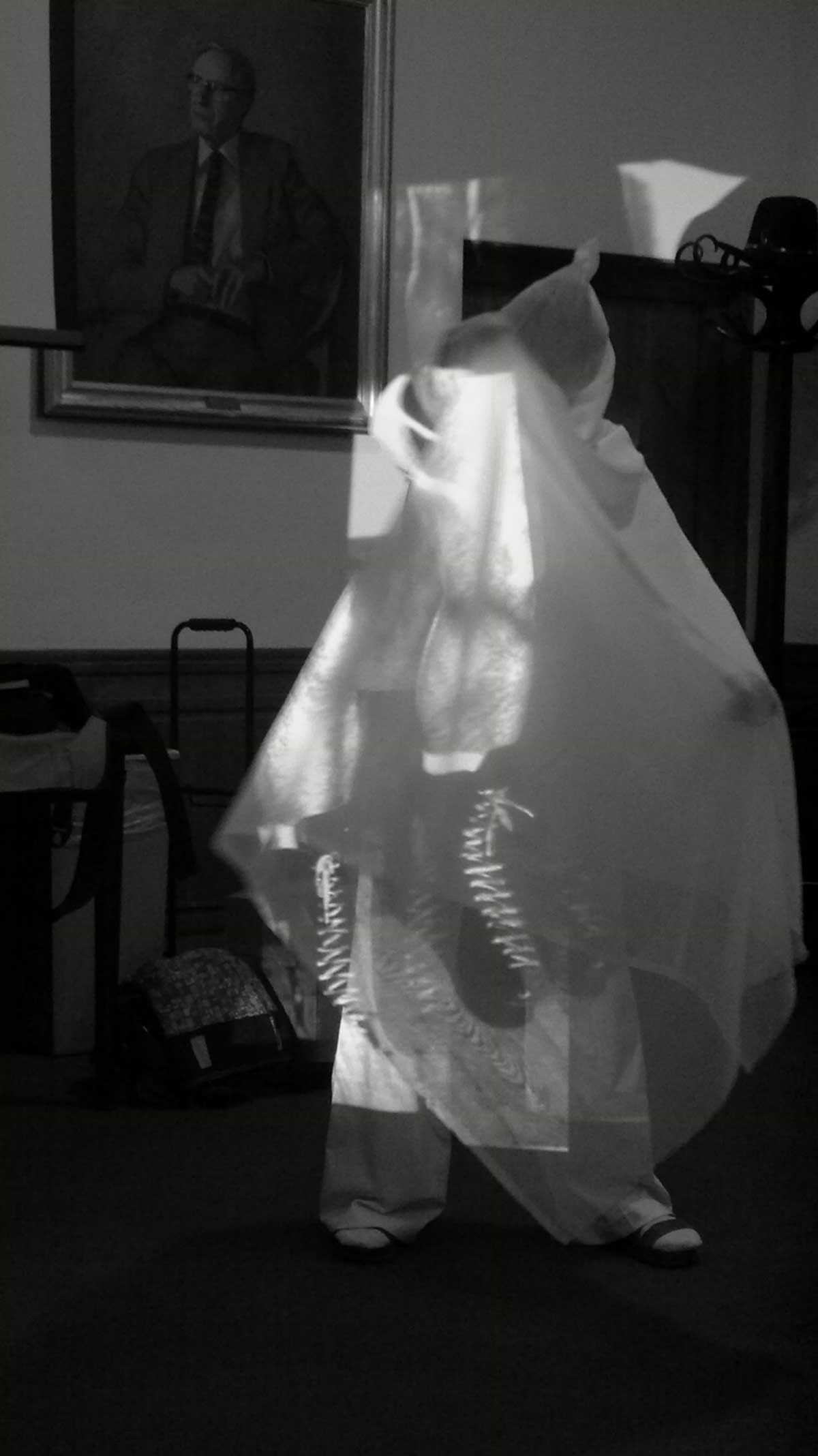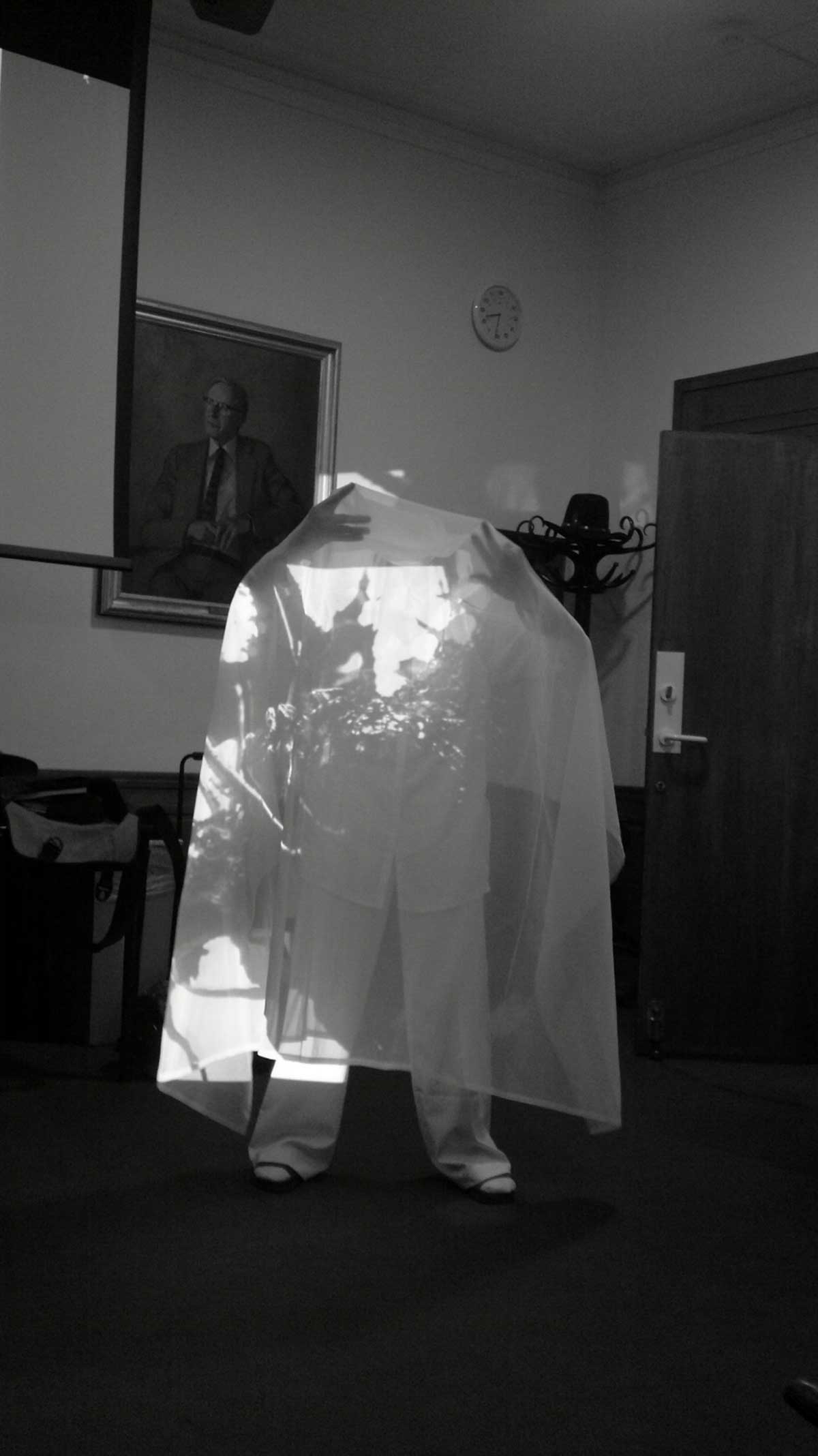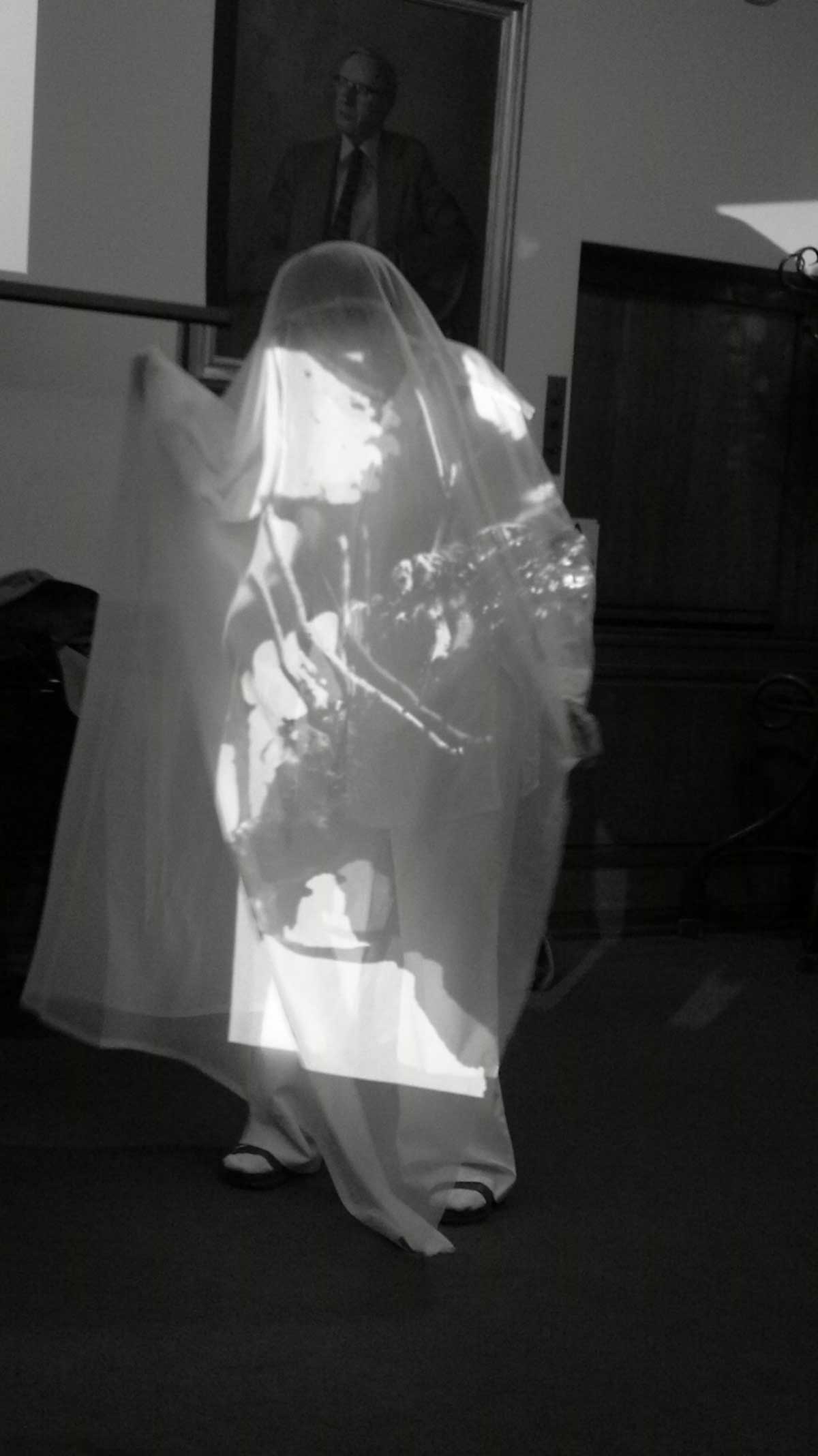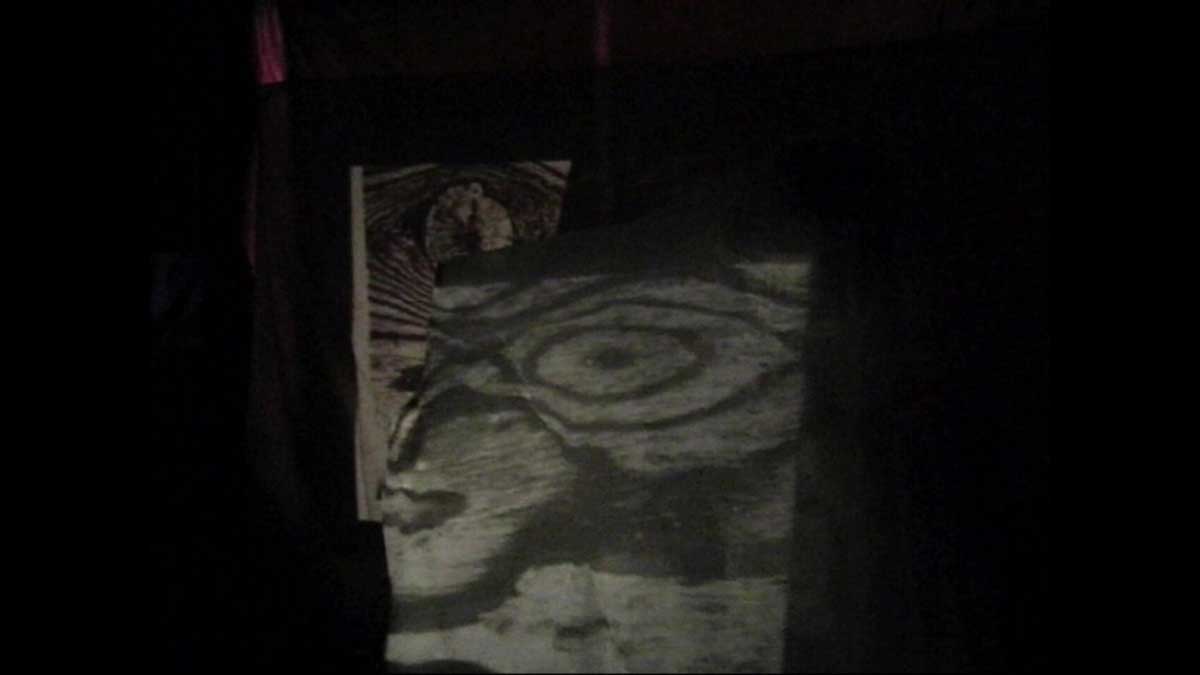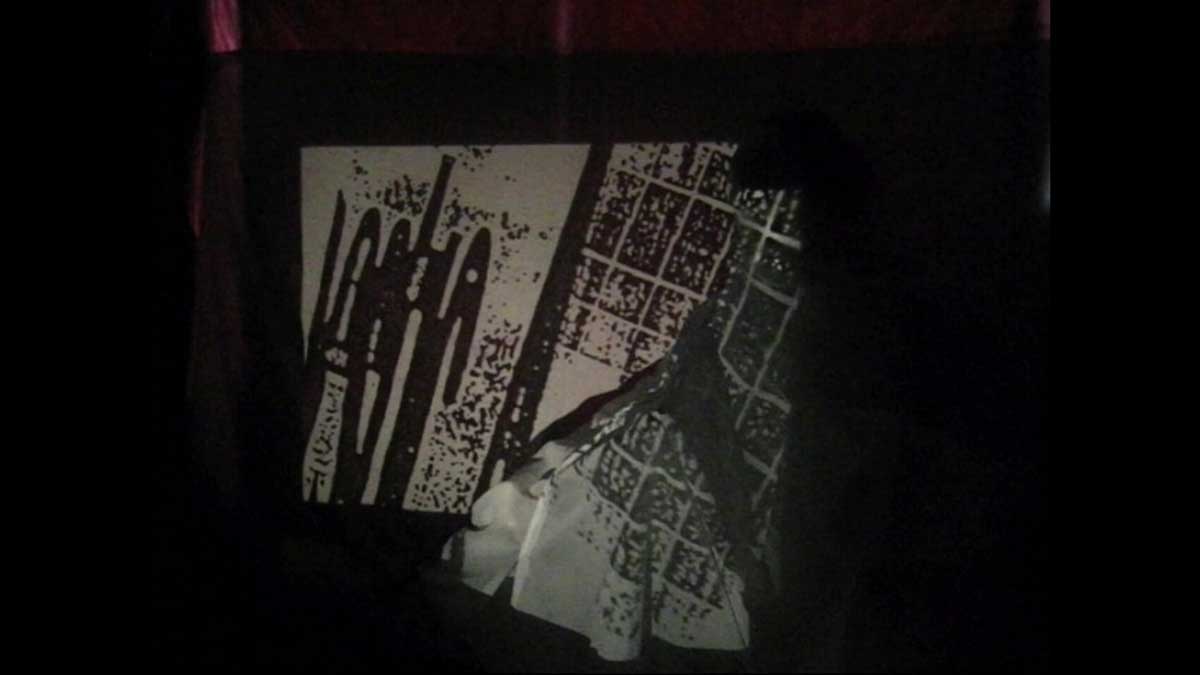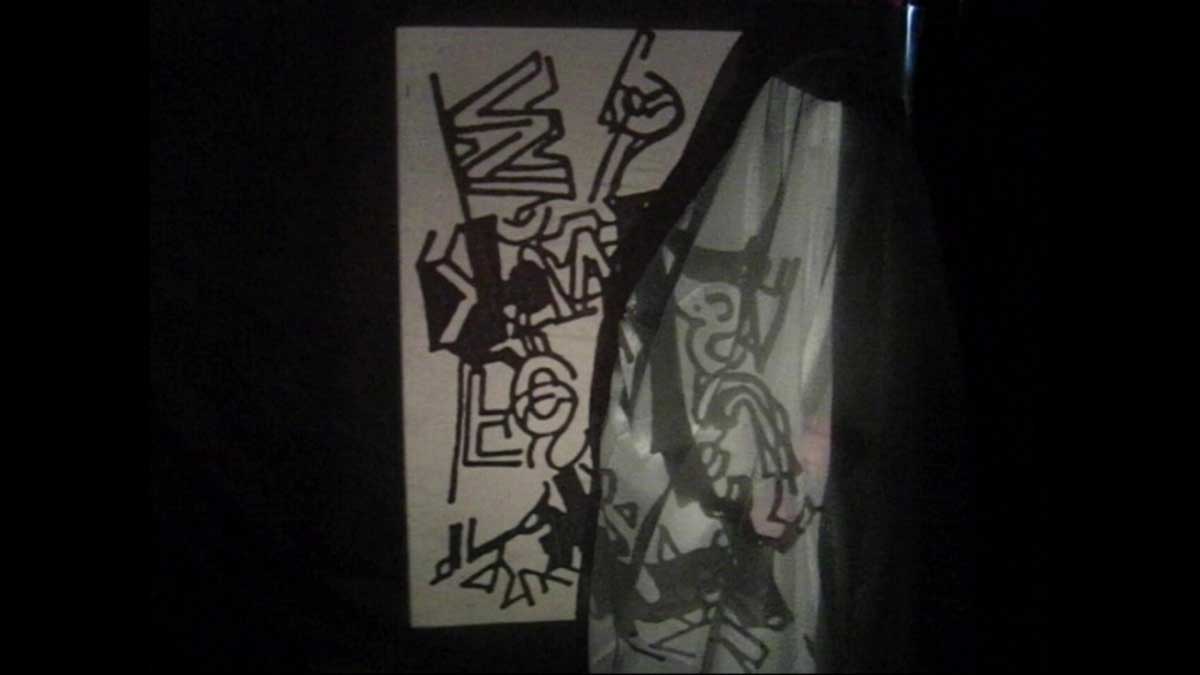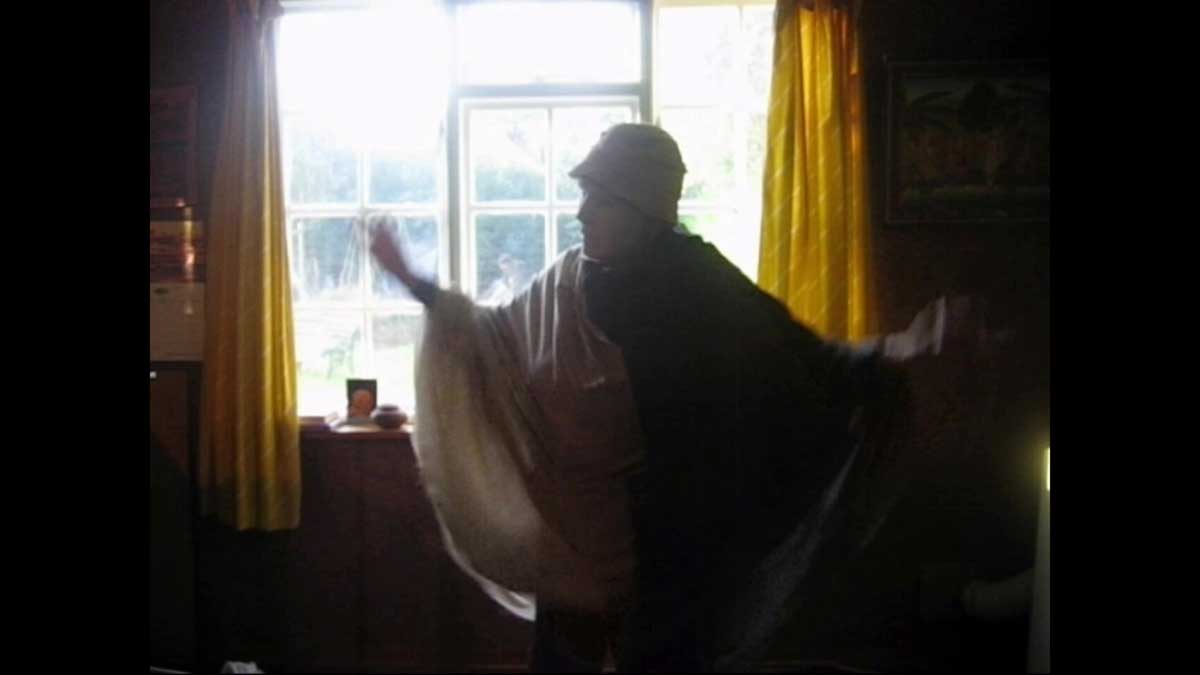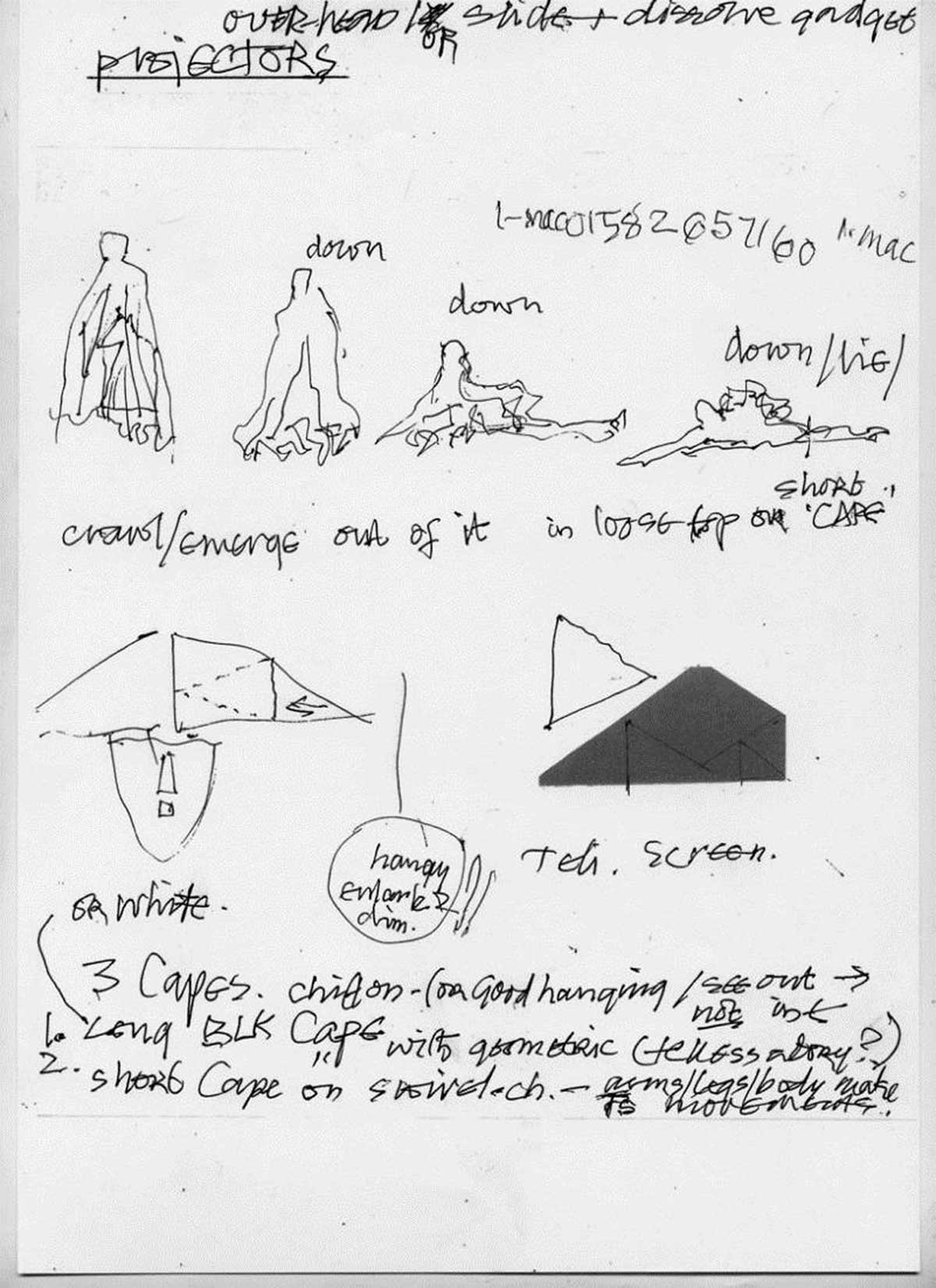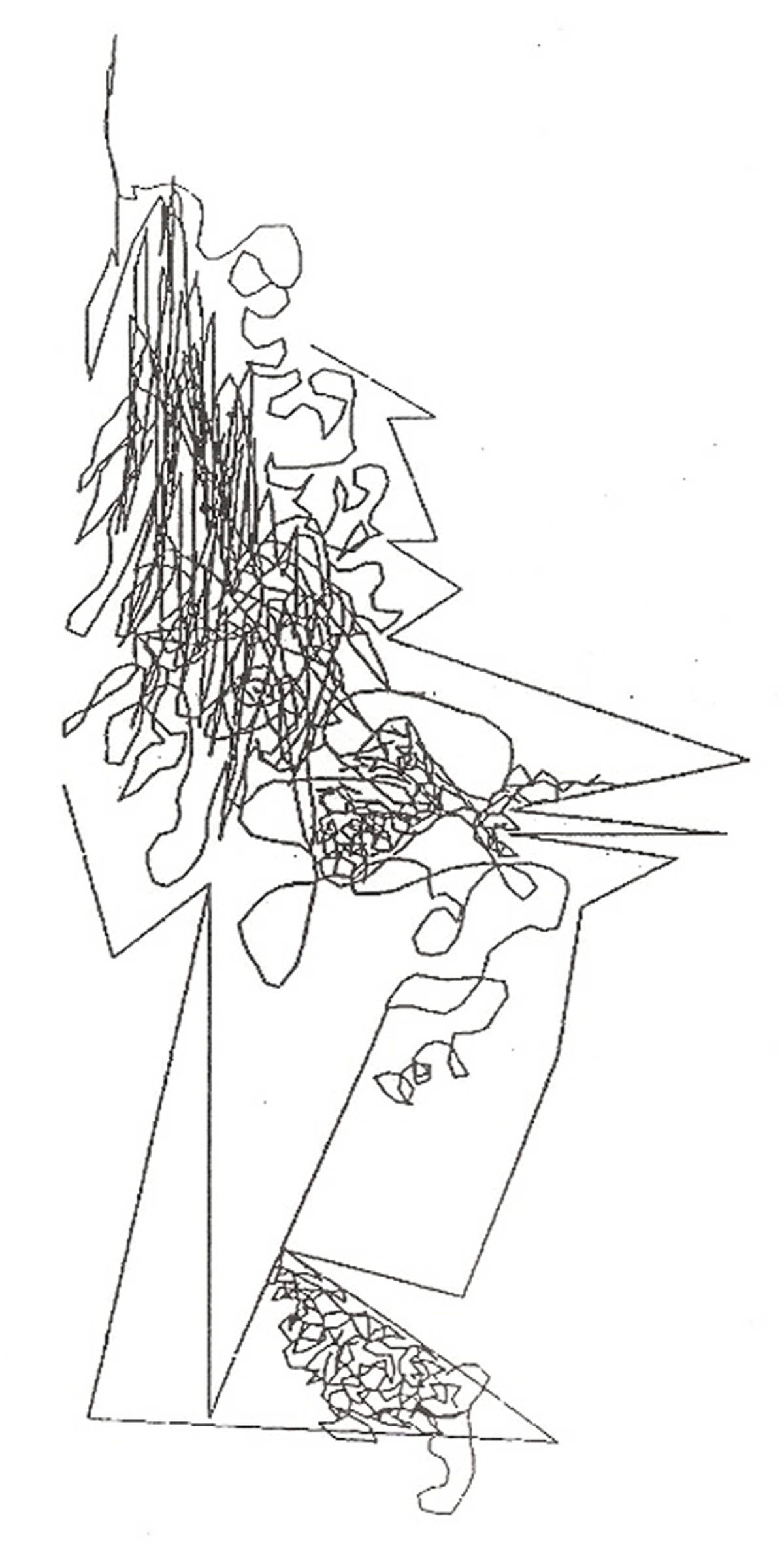Jennifer Pike (1920–2016) worked across the disciplines of painting, drawing, sculpture, textiles, ceramics, photography, jewellery-making, poetry and performance. She trained at the Royal Academy of Music Drama School, attended the Webber-Douglas School of Drama and Singing in London from 1944 to 1946, and worked for five years on tour and in repertory as Stage Manager, Stage Director, Actress and Producer, with repertory companies in Rugby, Wolverhampton and Birmingham before launching her own travelling repertory company in the Midlands in which she worked as Director and Producer for two years. Pike later went on to study painting, drawing and sculpture at Saint Martins, painting at the Central School of Art, textiles and ceramics at Camberwell, and ceramics and silversmithing in the Sir John Cass faculty of art. She then, by her own description in the introduction to the second volume of her two-part catalogue of works published by Veer Books in 2010, did various part-time jobs exploring ‘Arts/Crafts’ and taught painting, sculpture, kinetic art and experimental jewellery at City Literary Institute in London for twenty-six years. In 1963 she met and married Bob Cobbing (1920–2002), already a highly developed visual artist and writer beginning to come into his own as an activist, organiser and publisher. As Pike describes their relationship: ‘we lived and loved, and shared lots of things, including work to a degree; interests, values, etc. for 39 years’.1 The qualification that work was shared ‘to a degree’ seems also picked up when Pike recollects a dream she had shortly after her marriage to Cobbing:
We were sitting on a steep bank by a very beautiful stream/forest, very close together threading beads BUT – they were OUR OWN BEADS…. I remember thinking, later “I wonder if that’s how it is going to BE?…….? And, to quite a big degree, it was.2
This fascinating disclosure suggests an image of close companionship alongside creative autonomy, knit together by the pun on ‘beads’ and ‘be’, although in fact Pike would become an important collaborator in many of Cobbing’s projects. As the poet Adrian Clarke, published by Cobbing’s Writers Forum press (which he later helped to co-edit following Cobbing’s death in 2002 with Lawrence Upton, and in which Pike was a key figure) and co-editor with Cobbing of the occasional AND magazine, concluded his introduction to the first volume of the Veer catalogue: ‘If there is a School of Cobbing, the evidence here should remind us it has a sometimes neglected dimension.’3 As Lawrence Upton (1949–2020), another prolific collaborator with Cobbing, particularly in the 1990s, wrote:
If you would know Bob Cobbing then you must take account of the importance of Jennifer’s benign influence, companionship and support through the decades. In my judgement she is equally outstanding in her different artistic achievements. […] When one sees the totality of that shared commitment in practice, I think the quantity of Bob’s output seems less inhuman than it might!4
Upton’s phrase ‘shared commitment in practice’ seems a resonant way of capturing this remarkable relationship, but, as both Clarke and Upton acknowledge, it is partly the success and visibility of Cobbing’s work (although this was by no means consistent throughout his long career) that has contributed to the relative obscurity of Pike’s output. Although the Veer publications and Holly Antrum’s engaging portrait of Pike and her work entitled Catalogue (2012–14)5 begin to go some way towards addressing this problem, it is important to acknowledge the extent to which Antrum’s film was, as George Vasey has indicated, made ‘with rather than about’ Pike. As Antrum reflects:
I was mostly free from making sense of it all, or bearing its weight and legacy. […] I chose the film to be based on the ‘in-person’, rather than a researched profile of Pike. […] The film is also a non-catalogue, because there was little to refer to that was fixed and not subjective.6
The recent publication of Women in Concrete Poetry 1959–1979 (2020), edited by Alex Balgiu and Mónica de la Torre, which includes the work of Pike and her British contemporary, the Concrete, Sound and Visual poet Paula Claire,7 acknowledges the way in which the role of women in Concrete poetry and associated movements has been undervalued, downgraded or even erased.8 The editors quote Mirella Bentivoglio’s essay in the catalogue for the important Materializzazione del linguaggio exhibition of women’s concrete poetry at the Venice Bienniale in 1978 (the first exhibition in the Bienniale to be devoted to women artists) which featured work by Pike and Claire:
Obviously women aren’t the only ones engaged in this work, but they do have double the motivation for engaging in the discourse: in the past they’ve been rendered immaterial (dare I say dematerialized) by the ‘abstract sublimity’ of their public image, paralleled by their public absence; privately confined to daily, exclusive contact with the material world, women are now using every fiber of their beings to oppose a world rendered unreal (dare I say ‘derealized’) by repetitive mechanisms.9
Whilst progress has been made in the intervening decades, significant critical work remains to be done in this area.
In the context of inter-disciplinary dialogues between poetry and dance10 Pike’s work is a significant contribution, if the least well-documented aspect of her oeuvre. By attending to the relationship between these art forms in Pike’s practice, one might also begin to glimpse something more fundamental about the nature of interdisciplinary working. Pike performed dance and movement regularly as part of the music and poetry group Birdyak (comprising Pike, Bob Cobbing, Lol Coxhill and Hugh Metcalfe) from 1985 to 2002 at venues including The Klinker and Betsy Trotwood pubs in North London. She would wear costumes and masks, dancing to music and the spoken word, sometimes contributing spoken word herself.11 Despite beginning this practice in her mid-sixties, Pike’s 40s Drama school education might well have included some form of movement training and/or dance experience. Her painting and drawing, as well as works produced using a photocopier or computer, also convey a strong interest in the kinetics of the image in line with her description of her later work teaching ‘kinetic art’.12 Nevertheless, documentation of this aspect of her practice is scarce. The Conglomerization of Wot includes fifteen photographs by Aodhan McCardle of a 2003 performance at Camden People’s Theatre, London (with Coxhill, Metcalfe and pianist Veryan Weston) but, aside from a small number of photographs taken by private individuals, I have so far only been able to identify three extant video recordings – two of which will be considered in detail in this article.13
It is important to acknowledge however, the extent to which the embodied aspect of this work of Pike’s appears to be in dialogue with key statements of Cobbing’s poetics which describe ‘bodily movement’ as an intrinsic part of Concrete and related practices, which, in turn, may have emerged as a result of their creative partnership. In 1970 Cobbing envisaged the contribution of ‘concrete sound poetry’ along two lines of development. One line was ‘the attempt to come to terms with scientific and technological development’, whilst the other, although evoking a more problematic ‘return to the primitive’, suggests
the coming together again of music and poetry, the amalgamation with movement and dance, the growth of the voice to its full physical powers again as part of the body, the body of language.14
When I interviewed Cobbing in 1993, he also remarked ‘poetry’s very much a bodily thing and if you’re not making full use of your body when you’re performing it, you’re really keeping it to yourself’.15 Pike’s dance practice clearly embodies this poetics, as I shall try to demonstrate in the following analyses. In the only other extended account of Pike’s movement work, cris cheek also notes ‘the spatial organisation, choreography, of Pike’s actions might be considered as a code analogous to language’ and evokes Pike’s ‘corporeal transformation of text’.16
In Rhythmic Subjects (2007), Dee Reynolds contends that uses of energy in movement, and their transformation, are essential to dance practice and analysis. This transformation is enabled by the kinaesthetic imagination which she argues is ‘both a response and an active resistance to constraining patterns of energy usage that are culturally dominant, and that shape the kinaesthetic experiences and habits of individual subjects’.17 In Reynolds’ accounts of the innovative practices of Mary Wigman, Martha Graham and Merce Cunningham, she links energy with rhythm through ideas of expenditure and economy: ‘innovative dance rhythms are grounded in changes in energy expenditure through new “economies” of energy, which can manifest the subject’s resistance to constraints and transform the “self”’.18 Although Pike did not produce any public statements of poetics, her body of work exhibits an energetic search for new forms of expression across a variety of disciplines in a way that suggests a desire to break free of conventional energetic economies, not least those that might proscribe dance performance for the older, female body.19 In her dance work, her use of costumes, masks and a large circular disc of ribbed Perspex – the latter used to alter her and the audience’s view of the performance – all suggest how her kinaesthetic imagination led her to create images that celebrate movement and which gesture towards transformative possibilities.20
The interdisciplinary nature of Pike’s work is also relevant to thinking about transformation, particularly in the context of her movement performances. The concept of vitality dynamics, taken from psychologist Daniel Stern’s work, is potentially useful here to describe some aspects of what is happening in an interdisciplinary performance context. Vitality, for Stern, is produced by the mind integrating many internal and external events, which nevertheless have a basis in physical action. For example, a movement of the hand creates a sense of time, shape and duration in the mind as well as the perception of a force behind it. Stern therefore posits a pentad of movement, time, force, space and intention/directionality, that gives rise to our dynamic experience of vitality.21 Such experiences include ‘the force, speed and flow of a gesture; the timing and stress of a spoken phrase or even a word; the way one breaks into a smile’.22 Stern was fascinated by how language (e.g. in words like ‘exploding, swelling, drawn out’23), and cultural practices encode vitality dynamics through their formal elements. He was particularly interested in interdisciplinary collaboration because he believed that vitality dynamics were transferable between art forms, and could therefore create an aesthetic effect of ‘pairing the similar with the “not exactly the same”’.24
Stern focused on time-based arts (music, dance, theatre and cinema) in particular, and how their distinctive formal elements convey the dynamics of experience, e.g. encoded in the musical concepts of tempo, timbre, pitch and rhythm. In a collaboration with theatre artist Robert Wilson, Stern recounts how the dynamics of ‘mental motions’ in Wilson’s mind – captured in a ‘micro-analytic’ interview – are transformed into the dynamics of bodily movement on stage, for example, transforming Wilson’s experience of his thoughts ‘not quite getting anywhere’ into an actor running in circles that do not complete themselves.25 Whilst Stern did not attend to the dynamics of language-based arts, he recognised that they have ‘implicit non-linguistic “rules”’ for expressing vitality forms,26 prompting the questions: ‘can the same vitality forms be triggered by two or more art forms? Will their effects be complementary or additive, or more than the sum of the parts? What may artistic collaborations tell us?’27
These approaches from Reynolds and Stern thus afford new opportunities for understanding the aesthetics of Pike’s movement work in these contexts. Firstly, by presenting her older body as a focus of interest in these performance situations, Pike suggests a resistance to dominant cultural patterns of constrained energy use for the older female body.28 Secondly, by participating in a multidisciplinary collaboration, her work helps to make visible the vitality dynamics active in a situation where time-based elements such as music and voice are being used to respond to a text of visual or concrete poetry.
Each multidisciplinary collaboration has its own structure of relationships. In Pike’s work with Birdyak, her movement appears to function as a part, or wholly-improvised response to the performance of Cobbing’s visual and verbal texts (as well as a response to the texts themselves) by the other members of the group using voice, saxophone, guitar and percussion, with, in the RCA film, Cobbing appearing to respond to Pike’s movement in turn as part of the ongoing performance. In Pike’s work with Veryan Weston, her movement takes place in front of projections of her visual texts, whilst Weston improvises on piano, reacting to her movement and images, as Pike in turn reacts to his performance, as well as responding to the kinetic qualities of her own images.
To consider the films in more detail, the RCA example comprises two quite distinct movement interventions in an otherwise longer programme. In the first performance of around five minutes (twenty-one minutes into the event), Pike appears draped in a yellow cape with a white mask, carrying a black plastic refuse bag which she swings gently and then places carefully at the front of the performance area. She extends her arms at shoulder height and begins to twist and turn them to manipulate the folds of the cape that she is wearing. She then draws out from the folds of the cape a translucent dark brown and white-striped scarf that is also attached to her neck. She displays the full length of the scarf to the audience before also beginning to manipulate it in a similar fashion to the cape. A very striking image is achieved by Pike drawing the scarf over her masked face in various directions, as if looking through it into the middle distance. Seemingly more in response to the growing wildness in the music at this point, she then vigorously manipulates cape and scarf, hiding the scarf again within the folds of the cape. Pike then makes some dynamic gestures with her hands while still holding the cape and then reaches down to pick up and present the plastic refuse bag to the audience. Reaching inside she pulls out a large ribbed disc of Perspex (a favourite prop) and discards the bag. Holding the disc up in front of her, it creates a striking fractured image in lines, reminiscent of the pattern of the scarf. Drawing out the scarf once again and throwing it over her left shoulder, it appears in the fractured image seen through the disc held with both hands on either side with arms extended from the shoulders. Pike turns as if to present this image to the rest of the group, to perhaps respond to it with their music. She then, holding the disc with one hand, holds up the scarf behind it and manipulates the image (see Figure 1.1). Letting the scarf go, she holds the disc at head height and again moves it in front of her (see Figures 1.2, 1.3). She follows this movement through towards Lol Coxhill and then holds and moves the Perspex disc directly in front of him as he performs – an image now clearly viewable from the audience’s point of view (see Figure 1.4). After a few seconds and strong repeated notes which suggest the conclusion to the piece, she brings the disc abruptly to her torso and the piece concludes.
This is a performance which seems to combine both prepared and improvised elements within its series of actions within the generic frame of reference of performance art. The prepared elements include the costume and the production of the Perspex disc (which suggest a link to Pike’s theatrical background and also, at least partially, conceal the performer’s identity, if only temporarily), whilst the exact movements made during the piece appear to be improvised. The crucial element that potentially binds the strongest images of the movement together with the visual text actually being performed, is that the text (seen lying on the table in front of Bob Cobbing but unlikely to be visible to most of the audience, and certainly not shown directly to the audience) appears to be made up in part by a dense pattern of black-and-white parallel wavy lines. This is likely to be an effect generated by physically moving a prepared text on the glass of a photocopier whilst the machine is copying. Thus, the effect of Pike holding up the striped scarf in front of her body and also using the Perspex disc which fragments an image into linear shapes are readable as responses to the visual text. Musically, throughout the performance Cobbing plays a bodrhan in a sustained rhythmic fashion whilst Coxhill and Metcalfe improvise on alto saxophone and acoustic guitar. Whilst the film does not always show all of the performers, and only Cobbing seems to be consistently focused on Pike, there does appear to be communication going on between the movement and the music although the text is only apparently visible to Cobbing. This is particularly clear in Coxhill’s response to the proximity of the Perspex disc in his suddenly dense and more abstractly textured playing at this point.
From the point of view of vitality dynamics, it seems clear that there is an underlying idea derived from the text that is being explored in a particularly direct fashion through Pike’s movement, costume and prop interventions as well as being responded to by the musicians, whose insistence on sticking to relatively sustained lines of musical enquiry throughout the piece might also be a response to the parallel lines of the visual text.
In the second performance of around four minutes, (forty-seven minutes into the event), the piece is underway for nearly a minute before Pike makes her entrance. She is dressed in a brightly-coloured patterned shawl over fawn slacks and black turtleneck and a soft black velvet hat with a wide purple band around it, in strong contrast to her earlier appearance, although the shawl recalls the cape. Moving mostly from her hips and shoulders in a rhythmic response to the music, she enters the performance space with her back to the audience, turns around to face the audience and then moves towards the back of the performance space. She wraps the shawl fully around her and makes a few bending and twisting movements, before sitting down on the end of an (armless) sofa next to the sofa on which Lol Coxhill is performing. Initially almost lying back on the sofa, Pike then comes forward and grips the back of the sofa. At this point her hands and knees are in dynamic relation to each other and she pulls her right knee up to her face with her right wrist, her more percussive, angular movement giving way to more flowing movement in her elbows and hands. Next, she comes fully off the sofa, crouching on the floor, before sitting back on it and again reaching fully forward towards the floor with arms at full reach between outstretched legs.
At this point, the music, which has otherwise maintained a fairly consistent balance between its elements and a shared rhythmic approach, quite dramatically changes with some very long sustained notes by Coxhill. Although the close-up of Pike at this point hides some of her movement, she has her eyes shut and seems to be concentrating very attentively on the music as well as the kinaesthetic feedback from her own body. The movement in her right hand is particularly complex and dynamic at this point – opening and closing, twisting and turning and using directionality in the fingers at different levels – gestures reminiscent of musical conduction. (see Figure 2.1).
With another sustained note from Coxhill and extended slow, chant-like notes from Cobbing, Pike’s left arm emerges from beneath the shawl and ascends until fully extended above her head, as if in time with the extent of the note (see Figure 2.2). On its descent, it makes a gesture as if flicking something away from it. Shortly after, the right-hand joins with it in a dynamic parallel motion as if finger clicking in unison (see Figure 2.3). There is a distinct pause where Pike appears to be listening with intense focus, then her hands move in parallel and pulsate in time with two strongly alternating notes from Coxhill, activating her shoulders and arms. In another key image-gesture, the left-hand rests whilst the right makes a couple of looping movements before the right arm extends straight behind Pike and she pivots forward from the hips, head down (see Figure 2.4). The fingers of the right-hand move in this extended position (it is possible that a long, sustained note by Coxhill is actually responding to this gesture at this point) and the arm is only gradually lowered in stages. Pike then lifts her head, bringing the right-hand in towards her chest, as the left moves to join it. She leans back, resting her left elbow on the back of the sofa and raising her right knee. Sitting more upright again, she raises her shoulders and allows her wrists and forearms to overlap, then moves her right arm up towards her face (see Figure 2.5). The left-hand slowly joins it and then both engage in a dynamic, alternating clawing movement across the chest. The hands then both descend and begin to move side to side, and then vertically parallel (thumbs uppermost) in counterpoint – the right making a sudden horizontal move. It seems at this point Pike is most likely responding to the angular plucking dynamics of Hugh Metcalfe on the guitar. The right-hand is then raised as a fist and the left-hand joins it. The final passage has both hands close to the face, opening and closing in seemingly rapt attention to the sonic dynamics, now slower and more spacious as the piece comes to its end, and concludes with the fingertips on both hands firmly coming together.
It seems probable that the bulk of the material in this movement performance is improvised, apart from a possible prior decision to perform in a mostly seated position. This decision seems a practical one given the length of the programme and the fact that Pike was eighty-two years old at the time of the performance, and yet her use of energy in this passage is very dynamic and expressive, full of fast and articulate hand and upper-body movement and quick dips towards the floor, evidencing considerable flexibility, strength and coordination.29 The movement language here is more detailed, gestural in parts, but also abstract, certainly closer to dance vocabulary than the performance art actions/theatrical elements of the earlier appearance.
It would require more complete documentation to obtain a full musical analysis of the event and to appreciate the complexity of the interaction between Pike and the other performers but this relationship is nevertheless clearly evident. One is able to glimpse the visual text which is the score for the piece on the table in front of Cobbing with a fairly evenly-dispersed pattern of white and black shapes peppered with possible letter characters. Although it is hard to suggest any obvious link between this and the dynamics of this particular performance, we are once again witnessing a group of artists highly familiar with one another, working within a very sophisticated and well-established performance idiom in which the vitality dynamics of the source text are transferred and extended into the mediums of voice, music and movement. The overall tone of Pike’s contribution seems to concern a desire to show how music might land in the listener’s awareness and inform movement arising primarily from the musical dynamics, but also, possibly, from images and other embodied sensations and emotions.
A key aspect of Pike’s approach to performance which is not apparent in the RCA event involves her use of projections of visual text into the performance space, and onto the body of the performer. This is one of the most innovative aspects of her practice and also furthers the transferring and interweaving of the multi-disciplinary elements of a performance to bring the vitality dynamics of the text itself more fully into play. In his account referred to earlier, cris cheek notes the role of the projection in Pike’s performance with Cobbing and Upton in the following terms: ‘the space between light source and projected texts is figured as an open book onto which her movements act as an embodiment of interpretation’.30 This was an approach developed in relation to Pike’s performance work with Cobbing and Birdyak, but also with Upton, with whom Pike co-convened a series of workshops at Chisenhale Dance Space in 2001 and 2002 under the title ‘Initial Dance (movement, space and poetry)’ (named after one of Upton’s texts). The text of a contemporary flier advertising the workshop proposed to address the following questions about performance practice:
visual texts as notation; performance decision-making; the text as performance environment and the creation and modification of space by image projection; the performance space as text; the performing figure as textual element + masks + costume – feedback across genres; movement implied in still images; gesture as a means of generating or modifying utterance; movement-utterance feedback/generation. Colour. Animation.31
In Upton’s essay ‘Poetry and Dance?’ he describes some of the territory explored during these workshops and some of the thinking behind Pike’s approach. Projection, at least in the collaborative performances of Pike, Upton and Cobbing, seems to have arisen as a solution to the text being equally available and visible to the performers and audience:
Cobbing liked to hold his text at arm’s length. […] I preferred dropping the text to the floor. […] As long as we had more than one copy of the text, it was OK to each do our own thing […]. But often we performed with Jennifer Pike, and my text then might be where she would dance. She herself complained that both our solutions left her without decent sight of the text; and that the audience might like to see the text throughout the performance.32
Although, as Upton notes, Pike and Cobbing had already used slides extensively, he identifies the development in their collective practice of projecting the text from slides as the first time that the printed version had been abandoned and that ‘the only copy of the score available was the slide’.33 Upton recounts some extraordinary features of Pike’s use of the projector:
It was heavy and was covered in body armour; and Jennifer had built a strong wire cage around it so that she could swing it by one hand as she danced in Birdyak. […] Jennifer was also adept at modifying the image as it was projected, not just tilting the machine or changing the focus, but passing the projected image through glass prisms.34
What was also crucial in this practice was Pike’s use of costume to allow her to physically intervene in the projection:
Jennifer made costumes for herself which, being light-coloured with a light-coloured mask, made her a moving screen; and she was able to walk into and out of the space of the main screen, whether it was a standard screen or a white wall or a sheet hanging in folds. It brought unpredictable complex movement into and out of the text. It blurred the distinction of the dancer and the text she was dancing.35
When Upton and Pike worked together to co-convene the ‘Initial Dance’ workshop, they experimented extensively with projected images. They constructed screens from a broad variety of materials and of different shapes and sizes, as well as experimenting with moving screens, moving projectors and dark screens. Most ambitiously a ‘mannekin’ (sic) of part of a text was constructed, the whole of which was projected on to a screen of folded material. As Upton recounts:
The dancer, dressed in the same material, stood in the screen, holding the mannekin in place in the whole projection, and neither could be discerned. As the dance began, the dancer emerged, arm in arm with the mannekin.36
Upton uses the phrase ‘virtual spaces’ to describe what was being created in this practice:
Within such virtual spaces, the possibility of multiple divergent-convergent performances in movement and in voice was not only encouraged and increased but almost the only thing which could be done! [Upton’s emphasis]37
This rigorous and complex engagement with ‘divergent-convergent’ performances across disciplines represents an enquiry preoccupied with formal and thematic analogies emerging between the vitality dynamics of each art form – perhaps most fully apparent in the interest in moments which blur the boundaries between forms, such as between the dancer and the text (see Figures 3.1, 3.2, 3.3).
Although there is very little documentation of Pike’s work with Cobbing, Upton and others in this manner, she continued these explorations of projected text with the musician Veryan Weston and there is a short film documenting some of these experiments on Weston’s website called ‘Project 87’ (so-called because it was made within a day or two of Pike’s 87th birthday). The film is comprised of a montage of extracts of a sustained series of performances using projections of slides of nine of Pike’s visual texts, followed by a performance without projections. There is a marvellous expressive range in the vitality dynamics of this complex duet (or even trio) between disciplines, unfolding in a variety of virtual spaces. One can clearly gauge how Weston reacts to Pike’s images and movement as well as how Pike also appears to respond in turn to the music as well as to the images, or, as Weston puts it: ‘[the] “movement” in the pictures’ (see Figures 4.1, 4.2, 4.3, 4.4).38
For example, in the opening piece, captioned by two numeral ‘1’s (after a remark of Pike’s in a little introductory segment that there are ‘two ones’ in her set of numbered slides), the image appears to be a close-up of a woodgrain surface with two large knots resembling two eyes and a smaller ring below them suggestive of a mouth (see Figure 4.1). Weston’s playing throughout is quite spare and spacious, with a fairly slow tempo, whilst Pike’s manipulation of the sheet creates at times the effect of facial expressions. At times, the music becomes more animated, as if in response to the personality of a character emerging from the image. In the second piece, the image is made up of a grid alongside a series of letter shapes which recall Soviet-era poster typography (as Weston suggests in his own account) (see Figure 4.2). From the outset, the music is brisker, more pointillist as if responding to the urban modernity suggested by the grid and the textured patterns within it. Whilst Pike remains mostly within the projection of the grid, her occasional interventions into the more typographical part of the image generates a different kind of musical response and, towards the end, Pike’s increasingly wild movement finds its accompaniment in Weston’s playing. Later in the sequence, two pieces with more recognisable letter shapes generate different kinds of responses. One involves letters and marks tangled together in a kind of network with two main vertical branches (see Figure 4.3). Weston’s playing is correspondingly cubist and fragmentary whilst nevertheless strongly rhythmical, whilst Pike’s movement is quite measured and contained. The other image is taken from Pike’s ABC&c (1986) and shows a capital letter ‘A’ drawn in outline and repeated in an overlapping pattern as to suggest a dynamic horizontal movement of ninety degrees (see Figure 4.4).39 The density of overlaid lines appears to give rise to Weston’s frenetic playing up and down the scales to respond to the illusion of movement. Pike’s intervention is slow and deliberate but nevertheless creates complex patterns which at one point feel quite disorientating.
Close attention to these pieces generates an appreciation of the interactive possibilities of performing in this mode. Whilst Pike’s presence in the Birdyak performances discussed earlier feels more like a temporary – if decisive – accompaniment, the sessions with Weston, which in turn repeat a methodology that Pike used with both Cobbing and Upton, show a much more precise, intimate and integrated relationship being explored between movement, image and music. In this mode, it is far easier to trace the vitality dynamics being engaged with across the three different mediums.
In the final performance of the ‘Project 87’ sequence (about two and half minutes of material) the curtains of the studio have been drawn back to reveal a view of the garden. Pike is initially standing motionless to the right of the image whilst Weston begins to improvise notes in a fast tempo in a high key on the piano. At the point that Weston’s playing slows to an ominous-sounding chord sequence in a lower key, Pike edges sideways into the centre of the image. Wearing a hat with mask and shawl the effect is disconcerting, as if miming the entry of a monster from the early days of cinema. Now, in silhouette against the light coming in through the window, Pike’s movement improvisation is mostly in the arms, and in the early stages looks as if it may also be responding to the movements of a person working in the garden, visible through the window (see Figure 4.5). The next passage seems to show Pike responding in a dynamic way to the slightly blues-inflected development of Weston’s playing at that point but, shortly afterwards, she makes a powerful open-armed gesture against the now more chaotic rhythmic flow of the music that seems to switch the initiative so that her movements become readable almost as a form of conduction of Weston’s playing. Weston reflected on this interchange in correspondence:
The final piece where she remains static for a period is precisely the period that I played a piece that I had written….this was not arranged before….she just got the drift of the music as being pre-arranged at the beginning….she instinctively started moving when I started improvising after playing the piece. Again I just watched her and used her movement as a kind of a musical conductor….and in doing so she also responds to what I am doing….so this is where it is interactive. (cf. n22)
As Weston emphasised elsewhere in the correspondence: ‘….it is only when I improvise that she begins to move…. I feel improvisation is a key creative process in her work’.40 This commentary reveals something about the interaction between prearranged/composed material and improvisation in this particular collaboration but also in Pike’s practice more generally. In correspondence, Weston mentioned a performance with Pike of his ‘Tessellations for Luthéal Piano’ in Brussels on 14 of March 2003,41 and shared scans of two handwritten pages by Pike including choreographic sketches and costume designs featuring polygons as a visual analogue for the tessellations being explored musically (see Figure 5). These pages are evidence that, if the details of the movement dynamics in any given event were nevertheless likely to be improvised, Pike was also setting parameters and making particular decisions in advance – as seems apparent in, for example, the first solo within the RCA film.
Pike’s private papers contain a transcript by Lawrence Upton of a discussion ahead of their co-convened ‘Initial Dance’ workshop. In considering the basic parameters for this work, Pike states ‘I don’t think I want to go into complete improvisation’ which leads into a discussion of Upton’s intention to keep the workshop focused on ‘poetry improvisation, rather than dance improvisation’ – although Pike has annotated ‘dance improvisation’ with the remark ‘improvised response (to the text)’.42 The discussion leads to questions of the possible role of dance notation (rejected by Upton) and reflects Pike’s concern that some of the participants of the planned workshop might wish to notate and/or have some sense of a plan before beginning a performance. Although clearly improvisation is important to both artists, this discussion again reflects how it is not seen as an exclusive modality for Pike’s work in this area.
Whilst much of Pike’s visual output in the form of paintings, drawings, photography, and jewellery demonstrates kinetic qualities, her 1995 book Computer Dances (reissued in a new edition from Writers Forum with an introduction by cris cheek in 2017) explicitly announces itself as ‘scores for dance’ whilst the title’s subtle ambiguity also contains the suggestion that ‘[the] computer dances’. As Pike’s foreword explains, the book came about by explorations on an Apple Macintosh computer owned by her son David Baily during regular visits to his home in Bristol, using three different graphics programs. Holly Antrum, who created some simple animations of some of the images for her Catalogue, has described them as ‘graphically simple with high contrast on the page’ and as manifesting ‘quick ways to represent something performative visually’.43 There is amazing variety in the forty-eight images contained in the book, a number of which appear paired across the verso and recto, suggesting different outcomes based on the same, or related material – sometimes the same image is simply presented in another orientation and/or a negative is presented as a positive. The images clearly code the kinetic dynamics of the vigorous play that went into their construction (and the digital still clearly betrays the haptic hand of the artist) and it is perhaps in this way that they are most suggestive as choreography for dance movement, however pictorial some of them may be – for example a short sequence within the book looks as if it is based on two sketches of urban skylines. One image is particularly suggestive of a human figure in movement (see Figure 6).
In conclusion, the sad passing of Jennifer Pike whilst the first draft of this article was being written offers an occasion for further developments in the critical analysis and evaluation of her work in various disciplines. Whilst Pike’s work has clearly suffered the widespread neglect shared by her female contemporaries in the realms of sound, concrete and visual poetry, the endlessly inventive and manifold nature of her output offers valuable resources to a new generation of embodied interdisciplinary artists working in the interstices of text, image and performance.
Although Stern considers movement as only one part of his pentad of space, time, movement, force and direction/intentionality, it is his interest in the translating of vitality dynamics across the boundaries of artistic practices that is particularly useful for capturing the engaged creative dialogues that Pike sought throughout her life across the different media in which she worked but also in the collaborations with other artists that were such an integral part of her practice. Pike’s kinesthetic imagination not only seeks to overflow the boundaries of the conventional separation between art forms but also to give expression to her own unique signature of being in the world. The most striking moments in Pike’s work therefore seem to be those which Stern describes as the ‘magic […] in pairing the similar with the “not exactly the same”’,44 where the combination of elements – dancer, text, music, projection, voice – amount to something ‘more than the sum of the parts’. At these moments there seems to be a blurring of distinctions between the giving and receiving of aesthetic information: a foregrounding of the performer’s role as both receiver of vitality dynamics and creator of new dynamics; the respondent to projected light whilst also the surface that reflects that light back to the audience. Pike’s kinepoetics (to repurpose a term borrowed from Suzanne Braswell45) puts movement at the heart of her practice, so that it becomes the sense through which all other experiences are processed, and through which conventional boundaries and dualisms are eroded and ultimately dissolved.
Although this article has chosen to focus primarily on Pike’s work as a dancer, the fact of her commencing this aspect of her practice in her mid-sixties, and continuing it into her early nineties, is not only a challenge to the conventional ‘economies of effort’ identified and discussed by Dee Reynolds, but is also potentially an example of the vitality-enhancing benefits of dance and movement practices. As Jan Bolwell writes:
Whilst dance in the Western world has succumbed largely to the stereotypical view of ageing, it also has the potential to transform that view. Dance can be a potent vehicle for personal growth, freedom, and development as the older person transitions to a new stage in his or her life.46
Thus, Pike’s dance practice can be read as not only challenging the conventions of acceptable everyday movement habits and strategies but also the repertoire of movement conventions associated with the ageing female body. It seems hopeful that the power, challenge and variety of Pike’s output will inspire a new generation of writer-performers to explore their kinaesthetic imaginations and contribute to a shared and evolving kinepoetics for the future.
AppendixKnown and/or documented performances by Jennifer Pike Cobbing involving dance movement between 1991 and 2011:
Unspecified venue – launch of Floating Capital with Sally Silvers and Hugh Metcalfe, c. 1991 (London)
Institute of Contemporary Arts, with Birdyak, March 1996 (London)
Sally O’Briens, with Birdyak, 30 July 1998 (London)
The Sussex pub – performance with Bob Cobbing and Lawrence Upton of Cobbing and Upton’s Domestic Ambient Noise (299–300), 31 March–2 April 2000 (London) (reviewed by Peter Manson at: https://petermanson.wordpress.com/prose/on-domestic-ambient-noise/ and described by cris cheek in ‘Bob Cobbing’s Performances’, see note 15)
Royal College of Arts, with Birdyak, 12 March 2002 (London) (film documentation by William Cobbing – privately owned)
Freedom of the City, Conway Hall, with Birdyak, 4 May 2002 (London). Viewable at: https://www.youtube.com/watch?v=ivn9jbvX-m8
Unspecified venue, performance with Veryan Weston of Weston’s ‘Tessellations for Luthéal Piano’, 14 March 2003 (Brussels), (two pages of choreographic sketches by Pike exist)
Camden People’s Theatre, with Hugh Metcalfe, Veryan Weston, Lol Coxhill, 2003 (London) (photo documentation by Aodhan McCardle in The Conglomerization of Wot)
Bury Art Gallery, performance with Patricia Farrell, Robert Sheppard and Philip Davenport to launch Farrell’s A Space Completely Filled with Matter (a dance text for Jennifer Pike) as part of the Bury Text Festival, May 2005 (Bury, Lancashire) (photo documentation by Philip Davenport – privately owned)
The Klinker, performance with Veryan Weston and Patricia Farrell of A Space Completely Filled with Matter, December 2005
Veryan Weston studio, private rehearsal, 2007 (film documentation by Veryan Weston under title ‘Project 87’, viewable at: http://veryanweston.weebly.com/films.html
Birkbeck College, University of London, solo performance to launch Pike’s The Conglomerization of Wot, 26 October 2011
Notes
- jennypikcob, The Conglomerization of Wot (London: Veer Books, 2010), p. 9. [^]
- Ibid., p. 9. [^]
- Adrian Clarke, ‘Introduction’ in Jennifer Pike Cobbing, SCRUNCH (London: Veer Books, 2010), p. 10. [^]
- Lawrence Upton, ‘Bob Cobbing: A Worker in Progress’ in Upton, Commentaries on Bob Cobbing (Liverpool: Argotist Ebooks, 2012), p. 45. Viewable at: http://www.argotistonline.co.uk/COMMENTARIES%20ON%20BOB%20COBBING.pdf. [^]
- First shown at the exhibition ‘Bob Cobbing: ABC in Sound’ at Liverpool John Moores Exhibition Research Centre, 9 October–22 November 2013. [^]
- Holly Antrum, ‘Catalogue’ in Antrum, ed., Outside Noise (Edinburgh: Edinburgh Sculpture Workshop, 2016), p. 7. [^]
- Claire’s work has also been similarly neglected in the UK, although the publication of a series of catalogues of her work (most recently the two volume Going for Gold, 2011) and her ongoing maintenance of the Paula Claire Archive (subtitled: from WORD to ART – International Poet Artists) since 1978, are important contributions to safeguarding women’s contributions to the field. [^]
- See Alex Balgiu and Mónica de la Torre, eds. Women in Concrete Poetry (New York City: Primary Information, 2020), pp. 13–14. [^]
- Cited in Ibid., p. 13. [^]
- For an overview of the field, see Scott Thurston and Sarie Mairs Slee (2017), ‘Vital Signs: Poetry, movement and the writing body’, Choreographic Practices, 8: 1, 9–25, doi: 10.1386/chor.8.1.9_1. [^]
- As Barbara Tomlin recounts (from an email to the author 20th September 2016):
[^]Among Jennifer’s own personal mullings-on-paper, there are two sheets, from 1996 or thereabouts, where, possibly at a stage in her life where she was needing to make exclusive decisions, she was reflecting on the different pulsing strands of her multi-creativity in about sixteen different areas of expressive involvement, together with comments made by others on her abilities: a dancer/dance teacher told her ‘You could have been a professional creative dancer.’ Another comment she’d noted down was ‘I thought Jennifer’s (dance)work was inspirational and I was moved by the feel of the images and the strange and particular movements she made.’ Her jottings mention a complimentary letter regarding her dance work, received from the editor of the Artists’ Year Book (Spring 1995?). These notes have no names attached, though. The only person named directly is Stephan Themerson who, after a dance/voice performance commented on Jenny to another person present ‘She really is outstandingly good at everything she does, isn’t she?’
- See the many images of her visual work in the two Veer volumes which demonstrate a distinctive approach to line and rhythm highly suggestive of movement. See also note 20 below for more specific examples. [^]
- These are William Cobbing’s film of Birdyak performing at the Royal College of Art, London on 12 March 2002; Veryan Weston’s film of him performing with Pike in his home studio in London in 2007 (viewable at: http://veryanweston.weebly.com/films.html) and a film of Pike dancing solo as part of the launch for The Conglomerization of Wot at Birkbeck College, London on 26 October 2011. The former two films are considered in this article. [^]
- Bob Cobbing and Peter Mayer, eds. Concerning Concrete Poetry (London: Writers Forum, 1978), p. 44. [^]
- Scott Thurston and Bob Cobbing, ‘Rituals in Sound, Patterns on the Page: The Concrete and Sound Poetry of Bob Cobbing: An Interview by Scott Thurston’, Journal of British and Irish Innovative Poetry, Vol. 4, No. 2 (2012), 137–141 (138). [^]
- Cris cheek, ‘Bob Cobbing’s Performances: Production and Circulation, of the text’, Journal of British and Irish Innovative Poetry, Vol. 4, No. 2 (2012), 159–189 (183). [^]
- Dee Reynolds, Rhythmic Subjects: Uses of Energy in the Dances of Mary Wigman, Martha Graham and Merce Cunningham (Alton: Dance Books, 2007), p. 1. [^]
- Ibid., p. 1. [^]
- See, for example, Jan Bolwell, ‘Wellbeing and the Ageing Dancer’ in, Karkou, V. et al., eds. The Oxford Handbook of Dance and Wellbeing (New York City: Oxford University Press, 2017), pp. 311–328. Bolwell examines the phenomenon of ageism in dance and the ‘societal barriers and stereotypical ideas of who should dance outside the studio and in the public arena’, particularly for older women (p. 314). [^]
- This kinetic approach to art is perhaps most simply illustrated by Pike’s work with number and letter forms, the repetition and overlaying of which create the illusion of movement. See for example pages 57, 60, 69, 70 and 72 in Scrunch and pages 115, 126–27, and the front cover of The Conglomerization of Wot. The work with number forms was published as the Writers Forum pamphlet 56 entitled Wump Ertater (March 1970) and the letter forms as Writers Forum pamphlet 380 entitled A B C &c (March 1986). The number work (in a sequence of 1–10) appears as Wump Ertater, A Number Progression in Balgiu and de la Torre’s anthology, pp. 322–331. [^]
- Daniel Stern, Forms of Vitality: Exploring Dynamic Experience in Psychology, the Arts, Psychotherapy, and Development (Oxford: Oxford University Press, 2010), p. 4. [^]
- Ibid., p. 6. [^]
- Ibid., p. 7. [^]
- Ibid., p. 78. [^]
- Ibid., p. 93. [^]
- Ibid., p. 77. [^]
- Ibid., p. 76. [^]
- It is of course possible to argue that Pike’s frequent appearance as a solitary female dancer in an all-male performance context in which men were using musical instruments and voice, simply reproduces sexist hierarchies of artistic production. [^]
- It is worth noting that Pike also had a reputation as a skilled pool player and would regularly beat all-comers in ad hoc tournaments at her local pub. [^]
- Cheek, 183. [^]
- Jennifer Pike, private papers, section entitled ‘Jennifer Pike Lawrence Upton ‘Initial Dance’ Project’. Courtesy of Barbara Tomlin. [^]
- Lawrence Upton, ‘Poetry and Dance?’, p. 2. First published in The Paper, Issue 6 (April 2003). References are to copy viewable on Upton’s website: http://lawrenceupton.org/reviews/pandd.pdf. [^]
- Ibid., p. 2. Upton’s reference to the text as a ‘score’ for performance is important. As he later explains: ‘the written text, from which the slides had been made, was a jumping off point for improvisation and not a full notation’, p. 3. [^]
- Ibid., p. 3. [^]
- Ibid., p. 3. [^]
- Ibid., p. 10. [^]
- Ibid., p. 10. [^]
- In an email to the author on 20 September 2016 Veryan Weston wrote:
In a follow-up email on 21 September 2016, Weston added:For the first part Jennifer had taken photographs of pictures she had drawn/painted/sketched/improvised over presumably several years (decades). There were then two more layers to this final product of the film. She wore a sheet with a part where she could see through it. She then stood in front of a film screen where slides of these pictures were being projected.
At this point I have to include my own involvement as an improvising musician. You will see from my website my involvement with visual ideas in music (rhythm being a part of this connection)….and Jennifer’s movement was a way of making an interaction on a musical level….but also there was ‘movement’ in the pictures and SHE used this as well as interacting with the music to make undulating shapes etc with the projections on the sheet she wore.
The final piece where she remains static for a period is precisely the period that I played a piece that I had written….this was not arranged before….she just got the drift of the music as being pre-arranged at the beginning….she instinctively started moving when I started improvising after playing the piece. Again I just watched her and used her movement as a kind of a musical conductor….and in doing so she also responds to what I am doing….so this is where it is interactive.
Both parts consist of compositional ideas mixed with a lifetime of many different layers of experiences……her contribution though can be comprehended as a great visual artist, an amazing original improvisor and a unique performance artist.
[^]Her pictures felt very rhythmic, some in an urban – geometric way, others in a more naturalistic way….some had an almost kind of early Russian 20C reference. So this is already food for the music….plus her own movements which added a dimension of movement and distortion….so it felt there was an affinity to play music with her and her work. So both the images and her interplay with them were integral to the end-product….[…]
I think she also got feedback from the music itself so fed her movements in to this….or at least responded….so it felt very much like a duet.
- From A B C &c (London: Writers Forum, 1986). Four pages (including the ‘A’ piece) included in Cobbing, Griffiths, Pike (eds.), Verbi Visi Voco: A Performance of Poetry (London: Writers Forum, 1992). [^]
- Veryan Weston, email to the author on 1 August 2016. [^]
- Robert Sheppard has written a poem about the experience of listening to a sound-recording of this performance and attempting to hear the movements of Pike within it: see Sheppard ‘background pleasures’ (book 2) in A Translated Man (Shearsman: Bristol, 2013). For more information about the ‘Tessellations’ piece, see Weston’s website at: http://veryanweston.weebly.com/tessellations.html. [^]
- Jennifer Pike, private papers, ‘Initial Dance’. [^]
- Antrum, ‘Catalogue,’ p. 22. [^]
- Stern, p. 78. [^]
- Suzanne Fuller Braswell, The Influence of Dance on Poetics, Performance and Art (1830–1930): A Revisionist Explanation of the Modernist Aesthetic (Balzac, Mallarmé, Colette, Duncan, Fuller, Duchamp), (Lewiston/Lampeter: The Edwin Mellen Press, 2017), pp. 3–4. [^]
- Bolwell, p. 327.
Acknowledgements
The author wishes to thank the following for their assistance in writing this article: Holly Antrum, David Baily, Adrian Clarke, William Cobbing, Maddie Coxhill, Ulrike Coxhill-Scholz, Patricia Farrell, Mendoza, Hugh Metcalfe, Barbara Tomlin, Lawrence Upton and Veryan Weston. Thanks are also due to the organisers of the ‘Outside-in / Inside-out’ festival (see abstract): Jeffrey C. Robinson, Colin Herd, Nuala Watt, Calum Rodger, nick-e melville and Lila Matsumoto.
Competing Interests
Scott Thurston is co-editor of this journal. The review process for this article was handled by co-editor Gareth Farmer with oversight from Martin Eve and Rose Harris-Birtill at the Open Library of the Humanities.

